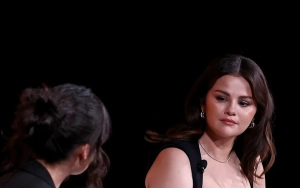
Queen Elizabeth's body was supposed to be transferred from Ireland to London by train but the plan was abandoned amid fears of stoking 'anti-monarchy sentiment.'
- Oct 10, 2022
AceShowbiz - Queen Elizabeth's body was not transported to London by train in case it stoked "anti-monarchy sentiment." Despite initial plan, her body was flown to RAF Northolt in London after the queen died last month at her Balmoral estate.
Retired Lt Col Anthony Mather reveals it took him more than a decade to draw up plans for "Operation London Bridge" - the codename given to the arrangements for when the monarch passed away - and he confirmed a special funeral railway carriage, which had glass windows and was illuminated to allow mourners to catch a glimpse of her coffin, was commissioned for the Royal Train if the queen died in Scotland.
However, Mather believes the railway option was discarded because of security risks and the amount of disruption it could have caused to the transport network.
He explained, "Every lamppost along the route would have had to be opened, checked for bombs and closed again. Also, there would have had to be police on every bridge along the way. And other trains would have been cancelled. It was decided this wouldn't start Charles off on the right foot with the general public."
There were also concerned the disruption would stoke "anti-monarchy sentiment" at odds with the mood during the nation's period of mourning.
The former Grenadier Guard worked with the Earl Marshal on the plans and led a team of 300 who met once a year to revise the funeral arrangements, but never spoke directly to the queen.
He told the Mail on Sunday newspaper, "The first draft I wrote was, I think, 15 pages long. My final copy, from 2017, is about two and a half inches thick. If you have a plan, you have to keep it up to date. Quite a big group met once a year - at the end of January - and we had a conference, the Earl Marshal's conference, where he took the chair and we explained any updates to the plans."
"In the latter years, we took over the whole of the ballroom at Buckingham Palace. We did it all through a PowerPoint presentation. People were sworn to secrecy - they didn't discuss it, other than with those people who needed to know."
"Whenever one saw the Queen, it was very formal. Discussion of the funeral was all indirect - it always went through a private secretary. You'd find a private secretary or a lady in waiting in a corridor and have a word. They tested the temperature of the water for me."
Mather would write out his suggestions to the private secretary, and the note then went to the queen in one of her red boxes and she would reply with handwritten notes in the margin.
The 80 year old - who assisted with the ceremonies for the Queen Mother, Princess Margaret, and Prince Philip and had just 48 hours to write a funeral plan for Princess Diana - and his team worked on a number of possible scenarios, including the queen dying at sea, at Prince Philip's remote Wood Farm cottage at Sandringham, or in Northern Ireland.
Part of the planning involved "sussing out" royal residences, and he was once almost caught in the act by the late Duke of Edinburgh. He recalled, "I have been many times to suss out Royal residences and the routes to bring the coffin down the stairs. I very nearly got caught out.
"I went for the same reason to Sandringham, to Wood Farm, where Prince Philip lived, and we were going there because we knew he was out . . . because they have a problem in that farmhouse. The stairs are very steep."
"I was going with the agent at the time and we turned into the drive, and he suddenly threw the car into reverse because Philip was coming round the corner. One would never do it while he was there - it would be insensitive."
There was also a rehearsal for the queen's lying in state at Westminster Hall, with a replica of the building constructed in an aircraft hangar.
He said, "I attended one Sunday morning. The catafalque had been hastily constructed, but obviously of the correct dimensions. The build gave a chance for TV and radio to see what the hall would look like, and for them to request camera positions."









